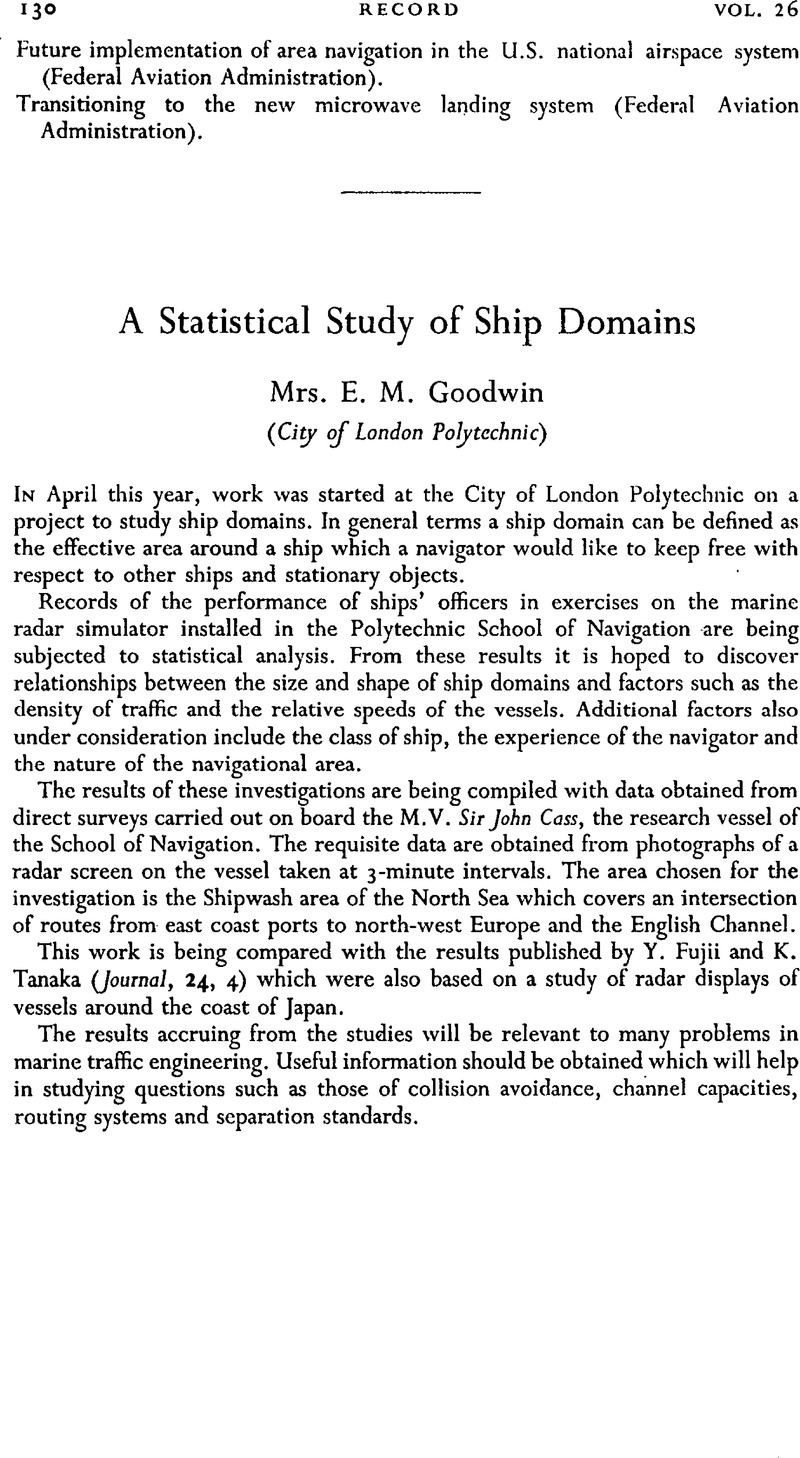Crossref Citations
This article has been cited by the following publications. This list is generated based on data provided by Crossref.
Froese, J.
2015.
Transport of Water versus Transport over Water.
Vol. 58,
Issue. ,
p.
281.
Krata, Przemysław
and
Montewka, Jakub
2015.
Assessment of a critical area for a give-way ship in a collision encounter.
Archives of Transport,
Vol. 34,
Issue. 2,
p.
51.
Tu, Enmei
Zhang, Guanghao
Rachmawati, Lily
Rajabally, Eshan
and
Huang, Guang-Bin
2018.
Exploiting AIS Data for Intelligent Maritime Navigation: A Comprehensive Survey From Data to Methodology.
IEEE Transactions on Intelligent Transportation Systems,
Vol. 19,
Issue. 5,
p.
1559.
Yang, Dong
Wu, Lingxiao
Wang, Shuaian
Jia, Haiying
and
Li, Kevin X.
2019.
How big data enriches maritime research – a critical review of Automatic Identification System (AIS) data applications.
Transport Reviews,
Vol. 39,
Issue. 6,
p.
755.
Lamm, Arne
Moller, Julius
and
Hahn, Axel
2020.
Collision Risk Model for Encounter Situation Assessment Based on Empirical Observations.
p.
1.
Gil, Mateusz
2021.
A concept of critical safety area applicable for an obstacle-avoidance process for manned and autonomous ships.
Reliability Engineering & System Safety,
Vol. 214,
Issue. ,
p.
107806.
Li, Mengxia
Mou, Junmin
Chen, Linying
He, Yixiong
and
Huang, Yamin
2021.
A rule-aware time-varying conflict risk measure for MASS considering maritime practice.
Reliability Engineering & System Safety,
Vol. 215,
Issue. ,
p.
107816.
Qin, Tingrong
Ma, Guoliang
Li, Dongyang
Zhou, Xinjie
He, Xingjie
and
Chen, Weijiong
2021.
Dynamic risk prewarning in ship encounter process considering domain violation.
Journal of Navigation,
Vol. 74,
Issue. 6,
p.
1416.
Qi, Le
Ji, Yuanyuan
Balling, Robert
and
Xu, Wenhai
2021.
A cellular automaton-based model of ship traffic flow in busy waterways.
Journal of Navigation,
Vol. 74,
Issue. 3,
p.
605.
Zhao, Liangbin
and
Fu, Xiuju
2022.
A Method for Correcting the Closest Point of Approach Index During Vessel Encounters Based on Dimension Data From AIS.
IEEE Transactions on Intelligent Transportation Systems,
Vol. 23,
Issue. 8,
p.
13745.
Wielgosz, Miroslaw
Pietrzykowski, Zbigniew
and
Chen, Peng
2022.
The ship domain in navigational safety assessment.
PLOS ONE,
Vol. 17,
Issue. 4,
p.
e0265681.
Sawada, Ryohei
Sato, Keiji
and
Minami, Makiko
2024.
Framework of safety evaluation and scenarios for automatic collision avoidance algorithm.
Ocean Engineering,
Vol. 300,
Issue. ,
p.
117506.
Zhou, Yu
Du, Weijie
Liu, Jiao
Li, Haoqing
Grifoll, Manel
Song, Weijun
and
Zheng, Pengjun
2024.
Determination of Ship Collision Avoidance Timing Using Machine Learning Method.
Sustainability,
Vol. 16,
Issue. 11,
p.
4626.
Yang, Ying
Liu, Yang
Li, Guorong
Zhang, Zekun
and
Liu, Yanbin
2024.
Harnessing the power of Machine learning for AIS Data-Driven maritime Research: A comprehensive review.
Transportation Research Part E: Logistics and Transportation Review,
Vol. 183,
Issue. ,
p.
103426.
Xie, Weidong
Gang, Longhui
Zhang, Mingheng
Liu, Tong
and
Lan, Zhixun
2024.
Optimizing Multi-Vessel Collision Avoidance Decision Making for Autonomous Surface Vessels: A COLREGs-Compliant Deep Reinforcement Learning Approach.
Journal of Marine Science and Engineering,
Vol. 12,
Issue. 3,
p.
372.
Park, Sangwon
Kang, Wonsik
Park, Youngsoo
Kim, Daewon
and
Shin, Ki-young
2024.
Ship Operators’ Perception Differences in Crossing Distance Between Vessels.
Journal of the Korean Society of Marine Environment and Safety,
Vol. 30,
Issue. 5,
p.
460.
Xiao, Zhongming
Hou, Baoyi
Ning, Jun
Lin, Bin
and
Liu, Zhengjiang
2024.
Collision Avoidance for Unmanned Surface Vehicles in Multi-Ship Encounters Based on Analytic Hierarchy Process–Adaptive Differential Evolution Algorithm.
Journal of Marine Science and Engineering,
Vol. 12,
Issue. 12,
p.
2123.
Li, Weifeng
Cheng, Ke
Shi, Guoyou
Desrosiers, Robert
and
Wang, Xinjian
2025.
Ship domain models: Reviewing the advancements and exploring the future directions in the maritime autonomous surface ships.
Ocean Engineering,
Vol. 326,
Issue. ,
p.
120935.
Gai, Xudong
Zhang, Qiang
and
Hu, Yancai
2025.
The Proceedings of 2024 International Conference on Artificial Intelligence and Autonomous Transportation.
Vol. 1390,
Issue. ,
p.
82.



